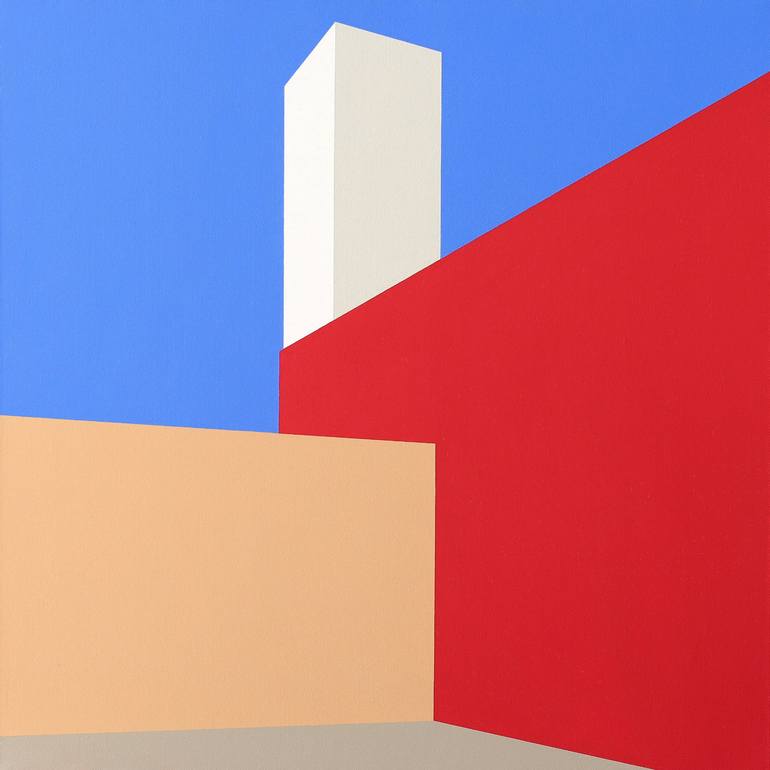





VIEW IN MY ROOM
Tristezza Effimera Print
Spain
Select a Material
Fine Art Paper
Select a Size
10 x 10 in ($100)
Add a Frame
White ($80)
About The Artwork
Present-day architecture has often been inspired by different forms and expressions of modern art, although it has been so more frequently with abstract art. Many of the emblematic buildings of modern architecture, which every architect holds in their architectural imagination, can be directly related to works of art or artistic movements. These architectural works, which are the result of a process of purification and transposition, are like artistic ideas that have been translated and materialized into the real world, where they finally acquire the physical dimension in which human life unfolds, and that only architecture can offer. With these buildings, abstract art, a way of interpreting and synthesizing reality, drives at materializing itself in this reality and is as if an idea, after having gone through a process of changing over, returned to its original state. The work of Spada constitutes a further phase in this change of state, a new changeover that turns to placing these buildings into the abstract world of two-dimensional canvas-painting. This passing from one state to the other tends to refine the forms, eliminating the superfluous and bringing the essential to the fore – by means of suppression of the projected shadows and superfluous elements, for example – and in this really consists the strength of these paintings. The pictorial work of Spada falls, therefore, in the tradition of geometric abstractionism of the early twentieth century, that arose as a response to the excessive subjectivism of the plastic artists of former times, and which wants to distance itself from the majority of movements that try to represent a three-dimensional purely emotional reality. Parting from the critical discourse of abstract artist forerunners like Picasso, Malévich or Mondrian, and the purism of Le Corbusier or Ozenfant, Spada goes a step further and shapes what can be defined as “neopurism”.
Details & Dimensions
Print:Giclee on Fine Art Paper
Size:10 W x 10 H x 0.1 D in
Size with Frame:15.25 W x 15.25 H x 1.2 D in
Frame:White
Ready to Hang:Yes
Packaging:Ships in a Box
Shipping & Returns
Delivery Time:Typically 5-7 business days for domestic shipments, 10-14 business days for international shipments.
Handling:Ships in a box. Art prints are packaged and shipped by our printing partner.
Ships From:Printing facility in California.
Have additional questions?
Please visit our help section or contact us.
Present-day architecture has often been inspired by different forms and expressions of modern art, although it has been so more frequently with abstract art. Many of the emblematic buildings of modern architecture, which every architect holds in their architectural imagination, can be directly related to works of art or artistic movements. These architectural works, which are the result of a process of purification and transposition, are like artistic ideas that have been translated and materialized into the real world, where they finally acquire the physical dimension in which human life unfolds, and that only architecture can offer. With these buildings, abstract art, a way of interpreting and synthesizing reality, drives at materializing itself in this reality and is as if an idea, after having gone through a process of changing over, returned to its original state. The work of Spada constitutes a further phase in this change of state, a new changeover that turns to placing these buildings into the abstract world of two-dimensional canvas-painting. This passing from one state to the other tends to refine the forms, eliminating the superfluous and bringing the essential to the fore – by means of suppression of the projected shadows and superfluous elements, for example – and in this really consists the strength of these paintings. The pictorial work of Spada falls, therefore, in the tradition of geometric abstractionism of the early twentieth century, that arose as a response to the excessive subjectivism of the plastic artists of former times, and which wants to distance itself from the majority of movements that try to represent a three-dimensional purely emotional reality. Parting from the critical discourse of abstract artist forerunners like Picasso, Malévich or Mondrian, and the purism of Le Corbusier or Ozenfant, Spada goes a step further and shapes what can be defined as “neopurism”.
Thousands Of Five-Star Reviews
We deliver world-class customer service to all of our art buyers.
Global Selection
Explore an unparalleled artwork selection by artists from around the world.
Satisfaction Guaranteed
Our 14-day satisfaction guarantee allows you to buy with confidence.
Support An Artist With Every Purchase
We pay our artists more on every sale than other galleries.
Need More Help?